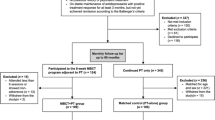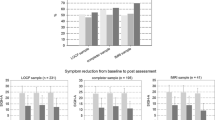Abstract
Adaption to changing environments is evolutionarily advantageous. Studies that link genetic and phenotypic expression of flexible adjustment to one’s context are largely lacking. In this study, we tested the importance of psychological flexibility, or goal-related context sensitivity, in an interaction between psychotherapy outcome for panic disorder with agoraphobia (PD/AG) and a genetic polymorphism. Given the established role of the 5HTT-LPR polymorphism in behavioral flexibility, we tested whether this polymorphism (short group vs. long group) impacted therapy response as a function of various endophenotypes (i.e., psychological flexibility, panic, agoraphobic avoidance, and anxiety sensitivity). Patients with PD/AG were recruited from a large multicenter randomized controlled clinical trial on cognitive-behavioral therapy. Pre- to post-treatment changes by 5HTT polymorphism were analyzed. 5HTT polymorphism status differentiated pre- to post-treatment changes in the endophenotype psychological flexibility (effect size difference d = 0.4, p < 0.05), but none of the specific symptom-related endophenotypes consistently for both the intent-to-treat sample (n = 228) and the treatment completers (n = 194). Based on the consistency of these findings with existing theory on behavioral flexibility, the specificity of the results across phenotypes, and the consistency of results across analyses (i.e., completer and intent to treat), we conclude that 5HTT polymorphism and the endophenotype psychological flexibility are important variables for the treatment of PD/AG. The endophenotype psychological flexibility may help bridge genetic and psychological literatures. Despite the limitation of the post hoc nature of these analyses, further study is clearly warranted.
Similar content being viewed by others
References
Darwin C (1859) On the origin of species. Oxford World’s Classics, Oxford
Jablonka E, Lamb MJ (2005) Evolution in four dimensions: genetic, epigenetic, behavioral, and symbolic variation in the history of life. MIT Press, Cambridge
Homberg JR, Lesch KP (2011) Looking on the bright side of serotonin transporter gene variation. Biol Psychiatry 69:513–519
Hayes SC, Luoma JB, Bond FW, Masuda A, Lillis J (2006) Acceptance and commitment therapy: model, processes and outcomes. Behav Res Ther 44:1–25
Wilson DS, Hayes SC, Biglan A, Embry DD (2014) Evolving the future: toward a science od intentional change. Behav Brain Sci 37:395–416
Williams KE, Ciarrochi J, Heaven PCL (2012) Inflexible parents, inflexible kids: a 6-year longitudinal study of parenting style and the development of psychological flexibility in adolescents. J Youth Adolesc 41:1053–1066
Hayes SC, Strosahl KD, Wilson KG (2012) Acceptance and commitment therapy: the process and practice of mindful change. Guilford, New York
Kashdan TB, Rottenberg J (2010) Psychological flexibility as a fundamental aspect of health. Clin Psychol Rev 30:865–878
Gloster AT, Klotsche J, Chaker S, Hummel KV, Hoyer J (2011) Assessing psychological flexibility: What does it add above and beyond existing constructs? Psychol Assess 23:970–982
Latzman RD, Masuda A (2013) Examining mindfulness and psychological inflexibility within the framework of big five personality. Personal Individ Differ 55:129–134
Kämpfe C, Gloster AT, Wittchen HU, Helbig-Lang S, Lang T, Gerlach AL, Richter J, Alpers GW, Fehm L, Kircher T, Hamm AO, Ströhle A, Deckert J (2012) Experiential avoidance and anxiety sensitivity in patients with panic disorder and agoraphobia: Do both constructs measure the same? Int J Clin Health Psychol 12:5–22
Ruiz FJ (2012) Acceptance and commitment therapy versus traditional cognitive behavioral therapy: a systematic review and meta-analysis of current empirical evidence. Int J Psychol Psychol Therapy 12:333–357
Gloster AT, Klotsche J, Gerlach AL, Hamm A, Strohle A, Gauggel S, Kircher T, Alpers GW, Deckert J, Wittchen HU (2014) Timing matters: change depends on the stage of treatment in cognitive behavioral therapy for panic disorder with agoraphobia. J Consult Clin Psychol 82:141–153
Levin ME, Hildebrandt MJ, Lillis J, Hayes SC (2012) The impact of treatment components suggested by the psychological flexibility model: a meta-analysis of laboratory-based component studies. Behav Ther 43:741–756
Canli T, Lesch KP (2007) Long story short: the serotonin transporter in emotion regulation and social cognition. Nat Neurosci 10:1103–1109
Lesch KP, Waider J (2012) Serotonin in the modulation of neural plasticity and networks: implications for neurodevelopmental disorders. Neuron 76:175–191
Uher R, McGuffin P (2008) The moderation by the serotonin transporter gene of environmental adversity in the aetiology of mental illness: review and methodological analysis. Mol Psychiatry 13:131–146
Uher R, McGuffin P (2010) The moderation by the serotonin transporter gene of environmental adversity in the etiology of depression: 2009 update. Mol Psychiatry 15:18–22
Enge S, Fleischhauer M, Lesch KP, Reif A, Strobel A (2011) Serotonergic modulation in executive functioning: linking genetic variations to working memory performance. Neuropsychologia 49:3776–3785
Enge S, Fleischhauer M, Lesch KP, Strobel A (2011) On the role of serotonin and effort in voluntary attention: evidence of genetic variation in n1 modulation. Behav Brain Res 216:122–128
Enge S, Fleischhauer M, Lesch KP, Reif A, Strobel A (2012) Variation in key genes of serotonin and norepinephrine function predicts gamma-band activity during goal-directed attention. Cereb Cortex 24:1195–1205
Belsky J, Jonassaint C, Pluess M, Stanton M, Brummett B, Williams R (2009) Vulnerability genes or plasticity genes? Mol Psychiatry 14:746–754
Hayes SC, Sanford BT (2014) Cooperation came first: evolution and human cognition. J Exp Anal Behav 101:112–129
Pauli P, Conzelmann A, Mucha RF, Weyers P, Baehne CG, Fallgatter AJ, Jacob CP, Lesch KP (2010) Affect-modulated startle reflex and dopamine d4 receptor gene variation. Psychophysiology 47:25–33
Gloster AT, Lang T, Georgi N, Wittchen HU (submitted) How patients decide to engage in exposure predicts attrition: the importance of willingness
Gloster AT, Wittchen HU, Einsle F, Hofler M, Lang T, Helbig-Lang S, Fydrich T, Fehm L, Hamm AO, Richter J, Alpers GW, Gerlach AL, Strohle A, Kircher T, Deckert J, Zwanzger P, Arolt V (2009) Mechanism of action in cbt (mac): methods of a multi-center randomized controlled trial in 369 patients with panic disorder and agoraphobia. Eur Arch Psychiatry Clin Neurosci 259(Suppl 2):S155–S166
Gloster AT, Wittchen HU, Einsle F, Lang T, Helbig-Lang S, Fydrich T, Fehm L, Hamm AO, Richter J, Alpers GW, Gerlach AL, Strohle A, Kircher T, Deckert J, Zwanzger P, Hofler M, Arolt V (2011) Psychological treatment for panic disorder with agoraphobia: a randomized controlled trial to examine the role of therapist-guided exposure in situ in cbt. J Consult Clin Psychol 79:406–420
Lang T, Helbig-Lang S, Westphal D, Gloster AT, Wittchen HU (2012) Expostitionsbasierte therapie der panikstörung mit agoraphobie. Ein behandlungsmanual. Hogrefe, Göttingen
Nakamura M, Ueno S, Sano A, Tanabe H (2000) The human serotonin transporter gene linked polymorphism (5-httlpr) shows ten novel allelic variants. Mol Psychiatry 5:32–38
Wendland JR, Martin BJ, Kruse MR, Lesch KP, Murphy DL (2006) Simultaneous genotyping of four functional loci of human slc6a4, with a reappraisal of 5-httlpr and rs25531. Mol Psychiatry 11:224–226
Lesch KP, Bengel D, Heils A, Sabol SZ, Greenberg BD, Petri S, Benjamin J, Müller CR, Hamer DH, Murphy DL (1996) Association of anxiety-related traits with a polymorphism in the serotonin transporter gene regulatory region. Science 274:1527–1531
Bond FW, Hayes SC, Baer RA, Carpenter KM, Guenole N, Orcutt HK, Waltz T, Zettle RD (2011) Preliminary psychometric properties of the acceptance and action questionnaire-ii: a revised measure of psychological inflexibility and experiential avoidance. Behav Ther 42:676–688
Shear MK, Vander Bilt J, Rucci P, Endicott J, Lydiard B, Otto MW, Pollack MH, Chandler L, Williams J, Ali A, Frank DM (2001) Reliability and validity of a structured interview guide for the Hamilton anxiety rating scale (sigh-a). Depress Anxiety 13:166–178
Guy W (1976) Ecdeu assessment manual for psychopharmacology. U.S. Department of Health, Education, and Welfare, Rockwille
Barlow DH, Gorman JM, Shear MK, Woods SW (2000) Cognitive-behavioral therapy, imipramine, or their combination for panic disorder: a randomized controlled trial. J Am Med Assoc 283:2529–2536
Chambless DL, Caputo GC, Jasin SE, Gracely EJ, Williams C (1985) The mobility inventory for agoraphobia. Behav Res Ther 23:35–44
Chambless DL, Sharpless BA, Rodriguez D, McCarthy KS, Milrod BL, Khalsa SR, Barber JP (2011) Psychometric properties of the mobility inventory for agoraphobia: convergent, discriminant, and criterion-related validity. Behav Ther 42:689–699
Reiss S, Peterson RA, Gursky DM, McNally RJ (1986) Anxiety sensitivity, anxiety frequency and the prediction of fearfulness. Behav Res Ther 24:1–8
Alpers GW, Pauli P (2001) Angstsensitivitäts-index. Julius-Maximilians Universität, Würzburg
Smits JA, Powers MB, Cho Y, Telch MJ (2004) Mechanism of change in cognitive-behavioral treatment of panic disorder: evidence for the fear of fear mediational hypothesis. J Consult Clin Psychol 72:646–652
Bryant RA, Felmingham KL, Falconer EM, Pe Benito L, Dobson-Stone C, Pierce KD, Schofield PR (2010) Preliminary evidence of the short allele of the serotonin transporter gene predicting poor response to cognitive behavior therapy in posttraumatic stress disorder. Biol Psychiatry 67:1217–1219
Eley TC, Hudson JL, Creswell C, Tropeano M, Lester KJ, Cooper P, Farmer A, Lewis CM, Lyneham HJ, Rapee RM, Uher R, Zavos HM, Collier DA (2012) Therapygenetics: the 5httlpr and response to psychological therapy. Mol Psychiatry 17:236–237
Lonsdorf TB, Ruck C, Bergstrom J, Andersson G, Ohman A, Lindefors N, Schalling M (2010) The comtval158met polymorphism is associated with symptom relief during exposure-based cognitive-behavioral treatment in panic disorder. BMC Psychiatry 10:99
Bockting CL, Mocking RJ, Lok A, Koeter MW, Schene AH (2013) Therapygenetics: The 5httlpr as a biomarker for response to psychological therapy? Mol Psychiatry 18:744–745
Losos JB, Schoener TW, Langerhans RB, Spiller DA (2006) Rapid temporal reversal in predator-driven natural selection. Science 314:1111
Whelan R, Schlund MW (2013) Reframing relational frame theory research: Gaining a new perspective through the application of novel behavioral and neurophysiological methods. In: Dymond S, Roche B (eds) Advances in relational frame theory: research and application. New Harbinger Publications, Oakland
Glenn AL (2011) The other allele: exploring the long allele of the serotonin transporter gene as a potential risk factor for psychopathy: a review of the parallels in findings. Neurosci Biobehav Rev 35:612–620
Acknowledgments
We are grateful to all individuals who participated in this study. This work is part of the German multicenter trial “Mechanisms of Action in CBT (MAC).” The MAC study is funded by the German Federal Ministry of Education and Research (BMBF; Project No. 01GV0615) as part of the BMBF Psychotherapy Research Funding Initiative. The Principal Investigators (PI) of the centers with respective areas of responsibility in the MAC study are as follows: V. Arolt (Münster: Overall MAC Program Coordination), H.U. Wittchen (Dresden: Principal Investigator (PI) for the Randomized Clinical Trial and Manual Development), A. Hamm (Greifswald: PI for Psychophysiology), A.L. Gerlach (Münster: PI for Psychophysiology and Panic subtypes), A. Ströhle (Berlin: PI for Experimental Pharmacology), T. Kircher (Marburg: PI for functional neuroimaging), and J. Deckert (Würzburg: PI for Genetics). Additional site directors in the RTC component of the program are G.W. Alpers (Würzburg), T. Fydrich and L.Fehm (Berlin-Adlershof), and T. Lang (Bremen). The study was further supported by the DFG (SFB TRR 58 Z02 to JD and AR, C02 to JD, B06 to AR; DE357/4-1 to JD and AR; RTG 1256, to ARand JD). T. Töpner and C. Gagel are credited for excellent technical assistance.
Conflict of interest
Drs. Gloster, Gerlach, Hamm, Höfler, Alpers, Kircher, Lang, Deckert & Reif report no conflicts of interest. Dr. Ströhle received research funding from the German Federal Ministry of Education and Research, the European Commission (FP6) and Lundbeck, and speaker honoraria from AstraZeneca, Boehringer Ingelheim, Bristol-Myers Squibb, Eli Lilly & Co, Lundbeck, Pfizer, Wyeth and UCB. He was a consultant for Actelion. Educational grants were given by the Stifterverband für die Deutsche Wissenschaft, the Berlin Brandenburgische Akademie der Wissenschaften, the Boehringer Ingelheim Fonds, the Eli Lilly International Foundation, Janssen-Cilag, Pfizer and Eli Lilly & Co. Dr. Wittchen is or has been on advisory boards of Servier, Pfizer, and Lundbeck. He also has received via his university grant support by Novartis, Lundbeck and Pfizer. Travel compensation for scientific meetings was received from Servier, Pfizer, Lundbeck, and Novartis.
Author information
Authors and Affiliations
Corresponding author
Rights and permissions
About this article
Cite this article
Gloster, A.T., Gerlach, A.L., Hamm, A. et al. 5HTT is associated with the phenotype psychological flexibility: results from a randomized clinical trial. Eur Arch Psychiatry Clin Neurosci 265, 399–406 (2015). https://doi.org/10.1007/s00406-015-0575-3
Received:
Accepted:
Published:
Issue Date:
DOI: https://doi.org/10.1007/s00406-015-0575-3




